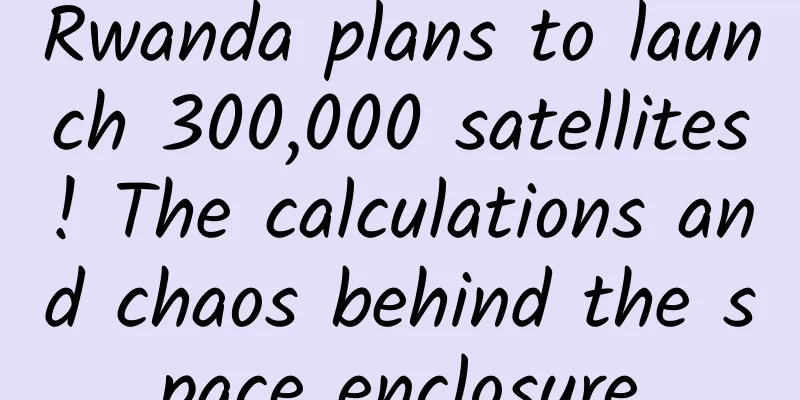Rwanda plans to launch 300,000 satellites! The calculations and chaos behind the space enclosure

|
In order to compete for limited orbital resources and frequency bands, various countries and satellite companies have submitted applications for the launch of more than 1 million satellites. However, this is just a "paper" satellite feast, and most satellites will not be actually launched. Behind the false prosperity, the lag of the existing satellite management system and the problems caused by space congestion are exposed. It is time to adjust the regulations and fix the loopholes. Written by | Lee Hyun-hwan Under the guise of technology, some incredible phenomena are happening in the satellite industry. For example, Rwanda, located in the interior of Africa, claims to launch 300,000 satellites into space. Regardless of whether this country has the will and necessity to achieve this goal, even if it is to be achieved, according to the current human rocket capabilities, it may take more than 100 years to deploy it. However, this goal that no one would take seriously has appeared on the international stage in a formal document application submitted to a UN agency. Perhaps because of the rapid development, contradictions and confusion in the satellite industry are emerging. The Rwanda case is just one of many. In fact, in recent years, the satellite plans proposed by various countries are extremely ambitious, and the total number of launches is expected to reach millions. But in reality, there are still less than 10,000 satellites in orbit around the earth, and most of the planned satellites have not been built, but remain on paper forever. What is the reason? This simple question involves complex factors such as the space vision of various countries and companies, the manufacturing and launch costs of space missions, and the iteration of management systems. In this article, we start with a latest study to dismantle the "chaos" of the huge satellite system and the various reasons and motivations behind it, and further understand how our satellites will be managed in the future? Where will the development of the human satellite industry go? Starting from 1 million “paper” satellites Recently, an article published in Science magazine pointed out that between 2017 and 2022, documents submitted by various countries to the International Telecommunication Union (ITU) showed that each company planned to launch more than one million satellites, involving more than 300 satellite constellations. This is a rather outrageous number. According to statistics from space agencies of various countries, there are currently about 7,000 to 8,000 artificial satellites in Earth orbit, and a considerable number of them are no longer in working order. Therefore, the number of satellites currently applied for by various countries is more than 100 times this number. This article published in Science reveals the absurd reality of millions of "paper" satellites. Prior application is a mandatory step in building a constellation system. Before launching a satellite, a country's government must submit a satellite plan to the ITU several years in advance. The ITU, as a regulatory agency, coordinates the radio spectrum for all parties to ensure that satellites do not fight with each other, that is, new satellite signals do not affect or even drown out existing satellite signals. Putting aside the feasibility, whether the million satellite plan is true or not, the problems it raises are obvious: 1. If most of the satellites involved in these applications are launched as scheduled, it means that thousands of rockets will be ignited and launched in the next few years. Satellites all over the orbit will make space more crowded, and the problems of collision and signal conflict will be greatly aggravated; 2. If the operators do not intend to launch these satellites at all, that is, these satellites remain "on paper", they may want to occupy a satellite position first, attract investors' attention, or eventually resell the radio spectrum, but this will also expose the obvious loopholes in the current management system, which can no longer keep up with the progress of the aerospace industry. Who is applying? In fact, most of the applications are visibly very strange. A typical example is that the Rwandan government submitted two satellite constellation applications to the ITU in September 2021, with a total of more than 300,000 satellites, which caused a sensation worldwide. In comparison, SpaceX, which currently launches the most satellites, has a total of about 5,000. Rwanda, located in East Africa, is still one of the least developed countries in the world announced by the United Nations. Its economy is mainly based on agriculture and animal husbandry, but it is still not self-sufficient in food. This country with a population of only more than 10 million and an area less than two times the size of Beijing, had a per capita GDP of less than one thousand US dollars in 2020, and a national GDP of approximately 11 billion US dollars. This figure is far from enough for them to build so many satellites. Penetrating the actual applicant behind the Rwandan government, we can further see the digital game of satellite operators. In fact, the initiator behind this application submitted through the Rwandan government is the French company E-Space. In addition, the company also submitted a satellite constellation plan of more than 100,000 satellites through French officials in 2023. The real initiator of Rwanda’s 300,000 satellite plan is this French company. But they never thought about actually launching so many satellites. The company's CEO stated in public that "at least 30,000 satellites will be launched", while their product development director said that "only a few thousand satellites will be launched". As they did, it is a fairly common operation for a company to submit applications in different countries and regions. For example, OneWeb, which operates more than 600 satellites, has submitted documents for 6,118 satellites through three countries (Mexico, France and the United Kingdom); SpaceX has submitted documents involving tens of thousands of satellites through the United States, Norway, Germany and Tonga. Similar practices can be seen in the shipping industry, where more than 44% of the world’s ships are registered in three countries: Panama, Liberia, and the Marshall Islands, due to looser regulations and enforcement and lower operating costs. One of the motivations is to apply for and obtain satellite orbits and then resell them to make money. For example, Tonga, a small island country in the Pacific, has never launched a satellite, but it applied for and obtained nine satellite orbits in the 1980s, and then rented them out to make millions of dollars. Now they are interested in the satellite business again. SpaceX submitted application documents for nearly 30,000 satellites through Tonga in October 2023. In addition, countries large and small, including China, Germany, Spain, Norway, France and the Solomon Islands, have submitted a large number of satellite file applications to the ITU. "But it's not just these huge numbers that interest us," Ivan Wright, a graduate student at the University of British Columbia and one of the authors of the aforementioned paper, said in an interview: "The more we delve into the issues of these constellations, the more we find that the ITU's supervision is completely behind the times." He said that many "paper" satellites will never be launched due to funding issues, political changes or technical problems. Why wasn’t it issued after I applied? First of all, it’s ability. Humans have limited ability to send things into space. Statistics show that in 2022, there were 186 orbital launches worldwide, 178 of which were successful, involving 8 countries and regions, sending 2,497 payloads and 24 astronauts into orbit. Without counting this year's figures, this is already the year with the most rocket launches, which can be regarded as the world's largest delivery capacity at this stage, with a maximum of more than 2,000. At this rate, it will take more than 400 years to launch one million satellites. Then there’s the cost. Taking the most popular Starlink as an example, Morgan Stanley once estimated that the manufacturing cost of Starlink satellites is $1 million per satellite, and Musk has publicly stated that the cost of a single satellite is expected to drop to $500,000. Since Starlink has not announced the manufacturing cost of satellites, and the specific figures will continue to change with technological iterations and expansion of production scale, this article takes its range and estimates it at the RMB to USD exchange rate of 7:1: the cost of a single Starlink satellite is about RMB 3.5 million to RMB 7 million. In comparison, a research report released by Zheshang Securities in September 2022 pointed out that the average cost of my country's current low-orbit communication satellites is about RMB 30 million. Since the scale of Starlink satellites has reached 5,000, far exceeding its peers, the industry generally believes that SpaceX can keep satellite costs to a minimum among satellites of the same level. However, even so, building satellites, especially satellite networking, is still a huge business that costs tens of billions of dollars to start. There are also launch costs, which account for nearly half or even more of the cost structure. SpaceX's own Falcon 9 rocket is the only launch vehicle in the world that can be reused on a regular basis. The average single launch payload mass reaches 11.13 tons, and the number of successful recovery has exceeded 100 times, which significantly reduces the cost of entering space. At present, the public price of Falcon 9 low-Earth orbit launch service is about RMB 26,000/kg (note that this is an external quotation rather than the cost price). Compared with other rocket launch services on the market, the price is half or even more cheaper. Launch prices for different types of rockets Starlink has barely become a low-orbit satellite constellation that has reached the profit line, with all-round cost advantages. SpaceX President and COO Gwynne Shotwell said in an interview with the media that Starlink is expected to start making a profit in 2023. The Starlink system is expected to cost about $2.41 billion per year. Since last year, Starlink has had more than 1 million users worldwide. From this perspective, other companies with higher manufacturing and launch costs than SpaceX face considerable challenges and doubts, and it is even harder to expect profits. Therefore, it is reasonable for everyone to be cautious and conservative when investing heavily in this extremely laborious but not necessarily pleasing business. Why apply if it’s not issued? Looking at the application documents involving 1 million satellites at this time, when everyone knows that the plan will not be implemented, whether it is companies or governments, they are submitting materials one after another. There must be very practical considerations of interests. In addition to showmanship (commercial and political levels), it also has important strategic significance: to seize orbital resources. Satellite orbits and frequency bands are considered a strategic resource. They are not only limited, but also have advantages and disadvantages. Because the propagation loss of different frequency bands is different, all parties need to compete for a better position. Internationally, the "first come, first served" approach is mainly adopted for satellite frequency and orbit resources. Therefore, developed countries are the first to launch satellites and occupy priority positions, resulting in congestion of high-quality orbits and frequencies. The ITU, which receives applications from various countries, is the organization responsible for coordinating and managing satellite orbits. Schematic diagram of the distribution of Starlink satellites in Earth orbit Furthermore, the situation is different in different orbits. For example, in the geostationary orbit about 35,000 kilometers from the ground, most satellites exist as single satellites, so orbital resources are relatively sufficient. The ITU wants to simplify the management of this orbit. When the satellite's 10-15 year life ends, it is usually artificially controlled to rise to an altitude of about 300 kilometers and enter the satellite "grave orbit" to become space junk, and its original position will be released. But the situation is different for the fiercely contested low-Earth orbit. Hundreds or even thousands of low-Earth orbit satellites need to form a constellation network at different altitudes below 2,000 kilometers. They will not be retired all at once. When some satellites are damaged or their lifespans have ended, operators will usually launch new satellites to supplement them instead of releasing the entire orbital resources. So the situation will become "first come, first served", and latecomers may face the passive situation of no orbit available in the future. How many satellites can be accommodated in the 300-1000 km low Earth orbit? There are many versions of the answer to this question. But what is certain is that the safety of artificial satellites will become an increasingly thorny issue. If 10% of the satellites that have been applied for are finally launched, the low Earth orbit will become more crowded with 100,000 more satellites. If satellites collide with each other, a large amount of space debris will be generated, which in turn will lead to more collisions. Against this backdrop, documents submitted by SpaceX to regulators in December last year showed that the Starlink satellite's automatic collision avoidance system conducted 26,037 orbital collision avoidance maneuvers between December 1, 2020 and November 30, 2022, with an average of more than 10 orbit changes for each satellite, showing that the threat is real. No matter from which angle we deduce, although space is infinite, the space left for latecomers will become smaller and smaller, and orbital resources will become an important threshold. what to do? The contradiction is becoming increasingly intense, and the phenomenon of millions of “paper” satellites shows that the current satellite management system is no longer sufficient to support the healthy growth of the satellite industry. Of course, to a large extent, this is also caused by the industry's development speed exceeding previous expectations. Referring to the development of the shipping industry, we only began to set foot in the ocean during the Age of Exploration from the 15th to the 17th century, and then the Industrial Revolution and the development of modern shipping technology brought us into the era of modern shipping. Since then, how should the high seas, which account for more than 60% of the world's ocean area, be managed? Countries have gradually formed the current joint governance system in the protracted tug-of-war. Space development is the new Age of Exploration. As for the outer space above 100 kilometers from the ground, it is a larger space with much rougher management at present. In addition, space is also a place that is in great need of order. Satellites are running in orbit, like walking on a highway in space, with a flight speed of 7-8 kilometers per second. Once a collision produces more debris, the consequences will be unbearable and unsalvageable. In this context, space satellite management involves the supervision and coordination of satellite orbits, spectrum, space debris, international cooperation and other aspects, which is crucial to ensuring the safety, sustainability and effectiveness of space activities. This puts higher demands on the ITU, a UN agency that was established even earlier than the UN itself. It brings together 193 member states every three to four years to discuss new rules for global communications. They are not without effort. In 2019, ITU member states adopted a regulation for satellite constellation networking: 10% of satellites must be launched within two years after the first launch, 50% within five years, and the entire constellation must be launched within seven years. The starting point of this regulation at the time was to prevent companies from occupying orbits without launching satellites. One of the details is that "the rules for frequency assignment of space radio stations for non-planned satellite networks are activated within seven years." That is, the first satellite can be launched within 7 years after the submission of the documents. There is a loophole here. In today's context of excessive submission of applications, this sentence can be understood as: everyone needs to wait 7 years to confirm that these "paper" satellites are fake. And according to ITU rules, after the satellite constellation is successfully applied for, if it is not used for 7 years, the final result is only that "the validity of radio frequencies and related orbital resources expires," which means that such "occupying" behavior does not have too much cost and punishment. The author of the aforementioned article stated that the ITU should consider speeding up this process and at the same time, introduce some charging mechanisms to restrict large-scale or speculative applications. Obviously, it is time to adjust the regulations and fix the loopholes. From November 20 to December 15, the World Radiocommunication Conference was held in the United Arab Emirates. The author of the aforementioned article pointed out in the article that the ITU should quickly revise the new regulations to solve the existing chaos in satellite constellations. In an interview with the media, the author stated that this year's conference will focus on issues related to satellite constellations, and also proposed reference ideas, such as limiting the number of satellites in each constellation, charging higher fees for larger-scale applications, or adopting a "deposit collection" approach, requiring companies to pay first when applying for satellite orbits, and then taking back the "deposit" after the satellite ends its service, etc. As long as companies and governments are prevented from making random applications, limited satellite orbital resources will be better utilized. At the same time, the ITU will be able to see the true intentions of all parties more clearly, thereby predicting the number of satellites in the future and making corresponding orbital and frequency arrangements, ultimately reducing the risk of radio frequency interference and collisions between satellites. Schematic diagram of retired satellites scattered throughout the orbit | Source: European Space Agency In addition, the strict management of satellites by the Federal Communications Commission (FCC) of the United States is also worth referring to. Last year, the FCC passed a new regulation requiring the proper handling of the "aftermath" of satellites, that is, low-Earth orbit satellites must be cleaned up by operators within five years after the end of their mission to avoid becoming uncontrolled garbage in Earth orbit. This is not just talk. Recently, the American TV company Dish became the first satellite operator to be fined because of this new rule. Dish said that one of its satellites was insufficiently fueled when it was decommissioned and could not be moved to the "graveyard orbit", so the company received a $150,000 fine. Although the number is not large, the company's stock price plummeted due to this, resulting in a market value loss of $100 million. As regulations become more detailed, the industry predicts that the demand for cleaning up space debris will increase significantly in the future. In fact, cleaning up space junk has been one of the directions for entrepreneurship in the commercial aerospace industry in recent years. These proposals and new regulations point to a more orderly and carefully managed era of space and air. As for the future management of space, the most urgent thing to do now is to deal with the millions of "paper" satellites. The author of the aforementioned article said, "Earth orbit is a limited resource belonging to all mankind, and we should maintain it well." References [1] https://theconversation.com/over-the-past-six-years-governments-proposed-launching-over-one-million-satellites-but-where-will-they-all-go-215979 [2] https://www.space.com/million-satellites-congest-low-earth-orbit-study-shows [3] https://www.astronomy.com/science/study-satellite-traffic-jam-calls-for-urgent-changes/ [4] https://adf-magazine.com/2022/08/rwanda-plans-to-launch-satellite-constellations/ [5] https://phys.org/news/2023-10-itu-tighten-orbit-satellites.html [6] https://www.space.com/how-many-satellites-fit-safely-earth-orbit [7] https://www.pnas.org/doi/10.1073/pnas.2221343120 This article is supported by the Science Popularization China Starry Sky Project Produced by: China Association for Science and Technology Department of Science Popularization Producer: China Science and Technology Press Co., Ltd., Beijing Zhongke Xinghe Culture Media Co., Ltd. Special Tips 1. Go to the "Featured Column" at the bottom of the menu of the "Fanpu" WeChat public account to read a series of popular science articles on different topics. 2. Fanpu provides a function to search articles by month. Follow the official account and reply with the four-digit year + month, such as "1903", to get the article index for March 2019, and so on. Copyright statement: Personal forwarding is welcome. Any form of media or organization is not allowed to reprint or excerpt without authorization. For reprint authorization, please contact the backstage of the "Fanpu" WeChat public account. |
<<: What to do if you accidentally lose your phone? It is crucial to do these things!
>>: How are the frozen pears in Northeast China frozen?
Recommend
Q&A on the unfair terms of telecommunications services!
[[129390]] I read an article today. Liu Min, depu...
What changes have taken place after the new Land Management Law is implemented in 2022? Attached with detailed rules
Since the new Land Management Law was implemented...
The Mauritius oil spill may have been caused by crew members using WiFi. The truth behind the Mauritius oil spill is revealed
Mauritius oil spill may have been caused by crew ...
Haoge's "We Media Ideas" story-based mid-length videos, how to quickly monetize mid-length videos
Contents: 1. Ideas: Only teach ideas, not techniq...
The sky is falling! Can young people also develop age spots?
We are all familiar with age spots. Many people t...
Note: You can breathe normally while reading this article
Review of this article: Zhang Ying, emergency sci...
How to promote an event well?
With the rapid development of various industries,...
Artificial Intelligence Threat Theory: What Are We Really Afraid of?
The man-machine Go battle finally came to an end ...
Driving sharing model: the secret to getting users to actively share traffic
Since the Internet traffic dividend began to grad...
Comment weight restored? Apple has caused trouble 4 times in less than a month. Developers: exhausted!
Apple's Black Thursday Thursday is actually a...
The love-hate relationship between development and testing
[[228041]] IT practitioners are always in dire st...
Cough cough cough cough! More and more people around me are catching colds and fevers. Is the new coronavirus making a comeback?
Audit expert: Chen Ying Doctor of Traditional Chi...
How to learn the "routines" and quickly and comprehensively become an industry expert!
In the field of operations , a major difference b...
my country adds 4 more world irrigation engineering heritage sites! Let's take a look at the ancients' wisdom in using water!
On November 4, the 2023 (10th batch) World Herita...









